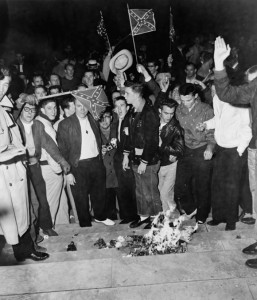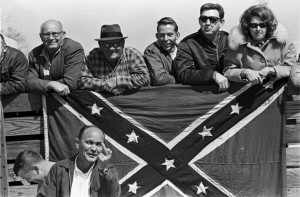The first time I saw a Confederate battle flag up close, I was in Kenya.
(You know, you really can’t predict what you will run into when you become a missionary).
Back around 1990, I was teaching American history to high school students at a boarding school in Kenya. Most of my students, the children of missionaries, were Americans from both the South and North. But I had a few Africans, Norwegians, Koreans, and Australians in the mix. When I got to the Civil War section of the semester, a student named Scott brought in his Confederate flag to display in class, as a matter of pride. With his Yankee classmates in mind (and his Yankee teacher, no doubt), Scott presented the flag like he was wearing a college football sweatshirt on the Friday before the big game. It was if he were bringing an Alabama Crimson Tide flag to a classroom with a bunch of Ohio State fans in it.

The classroom block at Rift Valley Academy in Kenya where I taught. I really wish I had a photo of me in class with Scott and the flag, but this was back in the days when I didn’t take a selfie of me and my students every fifteen minutes, like I do now.
(I really don’t know what the Norwegians and the Africans thought of all of this. But in that boarding school setting most students were used to odd cultural juxtapositions popping up regularly.)
Scott was a good guy: earnest, hard-working, a bit squirrely at times, but someone who wanted to do what was right.
So we had a conversation about the flag in class. I explained that he needed to realize that many people look at that flag and see racism. As I recall, Scott replied that he didn’t see racism when he thought of the flag. He said he thought about his family, and barbeques, and enjoyable times he had back home in Alabama.
And in that setting — a multi-national boarding school in Africa, with a framed picture of the Kenyan president hanging on the wall, jacaranda trees blooming outside our window, his parents 1400 miles away in Zambia, and his grandparents 8000 miles away in Alabama — I could see how the Confederate battle flag would elicit in Scott warm, cherished memories of home.
But then I think of another southerner. A black southerner: John Lewis. Born in 1940 near Troy, Alabama, Lewis attended segregated schools. After hearing Martin Luther King, Jr. on the radio, Lewis joined the Civil Rights movement. He participated in sit-ins at segregated lunch counters, joined the Freedom Rides on desegregated buses, suffered beatings by angry mobs, and was arrested more than forty times.
He also helped organize the famous march in Selma, Alabama in 1965, designed to insure that blacks in Alabama would be given their right to vote. In the march across the Edmund Pettus Bridge, Lewis was nearly beaten to death. Quite a few of the white state troopers who beat him had the Confederate battle flag on their helmets.
In that setting, I can see how the Confederate battle flag would elicit in John Lewis memories of inferior school facilities, police beatings, political resistance to equal rights, threatening epithets shouted by whites, and terrorists who killed blacks. The last of which, as the shooting in Charleston, South Carolina has reminded us, has not ended. (Actually, have any of them fully ended?)
Several observations. First, the Confederate battle flag is not one thing. I’ve seen people say it “is” racist and others say it “is not” racist. Strictly speaking, neither of those comments are true. The flag is a symbol, and symbols elicit all sorts of associations, images, connotations, and experiences. I associate the flag with a lot of things, including a classroom in Kenya, which I’m guessing is not a common connotation. I’ve only scratched the surface with Scott and John Lewis, for the associations are all over the map, so to speak.
The difficulty here is that symbols and images have power. This is why advertisers find all kinds of clever ways to stick scantily-clad women into commercials — those women will elicit all sorts of associations, images, connotations, and experiences (not necessarily healthy ones) in the minds of the viewer. If the scantily-clad women provoke positive connotations in the viewer, the viewer will automatically (without even thinking about it) feel more positive about the product which has, of course, no real connection to the scantily-clad women. But the viewer will be more likely to buy the product. That’s how symbols work. They influence behavior.
But not all associations are created equal. Some give a fuller picture of reality than others. Some — like Dylann Roof’s association of the Confederate flag with a race war he wanted to provoke — are quite dangerous. And whether or not the viewer realizes it or not, they are tied to history.
So how should we, as a society, handle these conflicted associations with the flag? It’s difficult. In the end, I think the problem with the Confederate flag is its history — a history that is tied too heavily to a burden of racial injustice. When Scott told me what the flag meant to him, as I recall, he didn’t make any historical references, even though it was a history class that provoked his actions. While his individual conception of the flag was not much of a problem, the flag is a social and cultural symbol, which is a problem. So while individual associations elicited by the flag may be harmless and sometimes even admirable, the cultural and collective history of the flag has been largely one that has elicited, supported and promoted racist behavior and systems.
How? Well, here is a brief history of the flag, in case you have not heard it by now. Many people today don’t realize that the Confederate battle flag had not been flown or displayed very much between the 1870s and the 1930s. During that time, it really was not a common symbol of the South. In 1948, some southern Democrats called Dixiecrats split with their party because they opposed civil rights legislation. In the process they waved, and in many ways resurrected, the Confederate battle flag as a symbol for their cause. From there, it appeared in all sorts of public conflicts over civil rights. Whites who burned civil rights literature waved the flag. Whites who appeared at civil rights marches to protest civil rights flew the flag. Soon, the flag was popping up all across the South. It spread into the white segments of southern culture. So, it started with a political movement to oppose equal rights, maintaining racist connotations in many quarters, even as it also spread out to comparatively harmless uses beyond the South, as can be seen with the “Dukes of Hazzard,” NASCAR races, and tacky coffee mugs.
Some people will say that the original use of the flag was not tied to racism. This is the historical argument that the South was fighting for states rights, not slavery, in the Civil War.
This is not an accurate understanding of American history. The essential reason that the southern states supported states rights and turned to secession was to preserve slavery. In other words, slavery caused the states rights agitation and was the primary cause of the Civil War. I can provide mountains of evidence for this. Academic historians know this, but alternative interpretations of the Civil War have been around a long time, (think of “Gone with the Wind”) telling the story of the war in ways that divorce it from slavery. These stories are deeply flawed.
Furthermore, the states rights dynamic lay behind the resurrection of the flag a century later. The state of South Carolina did not raise the flag over the capitol grounds until 1961, right in the middle of the civil rights conflicts. There were official pronouncements that this was to commemorate the centennial of the Civil War. Some people have argued, therefore, that the flag was not tied to racism, but to a war fought over states rights. Besides the flaw in this view of the Civil War, it masks another dynamic in the South in the 1950s and 60s. Similar to the political forces that caused the Civil War, opposition to civil rights drove a lot of southern states rights arguments in the 1950s and 60s.
I understand that some people hold warm and rather innocent associations with Confederate flag. However, this is largely possible because these associations have erased blacks and race relations from the history or from current conception of the South. And that is a problem.
And yet, even as I believe that the flag should come down from governmental sites, and even though I care about this issue, I actually have little emotional investment in this conflict, compared to many blacks and white southerners. As a white northerner, the flag neither forms a key part of my identity nor insults it. That makes it easy for me to take a stand. But there are historical and theological implications in an issue like this that are tougher to come to terms with. And they apply to everyone. So, for all of you non-southerners out there, I have more for you to think about, which I will get to in my next post.




